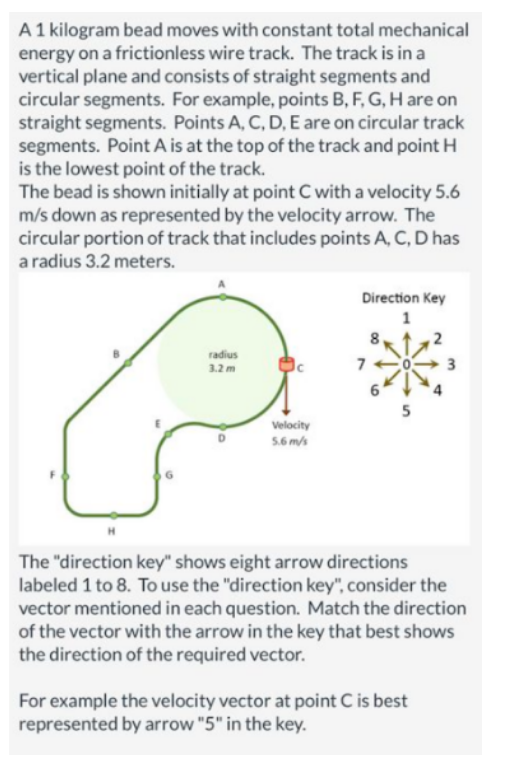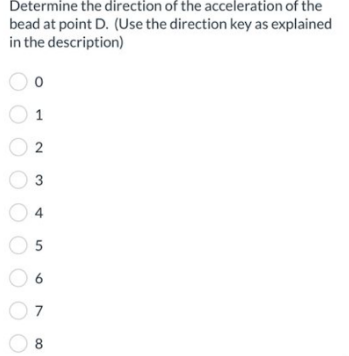A 1 kilogram bead moves with constant total mechanical energy on a frictionless wire track. The track is in a vertical plane and consists of straight segments and circular segments. For example, points B, F, G, H are on straight segments. Points A, C, D, E are on circular track segments. Point A is at the top of the track and point H is the lowest point of the track. The bead is shown initially at point C with a velocity 5.6 m/s down as represented by the velocity arrow. The
A 1 kilogram bead moves with constant total mechanical energy on a frictionless wire track. The track is in a vertical plane and consists of straight segments and circular segments. For example, points B, F, G, H are on straight segments. Points A, C, D, E are on circular track segments. Point A is at the top of the track and point H is the lowest point of the track. The bead is shown initially at point C with a velocity 5.6 m/s down as represented by the velocity arrow. The
Classical Dynamics of Particles and Systems
5th Edition
ISBN:9780534408961
Author:Stephen T. Thornton, Jerry B. Marion
Publisher:Stephen T. Thornton, Jerry B. Marion
Chapter9: Dynamics Of A System Of Particles
Section: Chapter Questions
Problem 9.19P
Related questions
Question

Transcribed Image Text:A 1 kilogram bead moves with constant total mechanical
energy on a frictionless wire track. The track is in a
vertical plane and consists of straight segments and
circular segments. For example, points B, F, G, H are on
straight segments. Points A, C, D, E are on circular track
segments. Point A is at the top of the track and point H
is the lowest point of the track.
The bead is shown initially at point C with a velocity 5.6
m/s down as represented by the velocity arrow. The
circular portion of track that includes points A, C, D has
a radius 3.2 meters.
radius
3.2 m
Velocity
5.6 m/s
Direction Key
1
7
5
2
The "direction key" shows eight arrow directions
labeled 1 to 8. To use the "direction key", consider the
vector mentioned in each question. Match the direction
of the vector with the arrow in the key that best shows
the direction of the required vector.
For example the velocity vector at point C is best
represented by arrow "5" in the key.

Transcribed Image Text:Determine the direction of the acceleration of the
bead at point D. (Use the direction key as explained
in the description)
O
0
1
2
3
5
7
8
Expert Solution
This question has been solved!
Explore an expertly crafted, step-by-step solution for a thorough understanding of key concepts.
This is a popular solution!
Trending now
This is a popular solution!
Step by step
Solved in 2 steps

Knowledge Booster
Learn more about
Need a deep-dive on the concept behind this application? Look no further. Learn more about this topic, physics and related others by exploring similar questions and additional content below.Recommended textbooks for you

Classical Dynamics of Particles and Systems
Physics
ISBN:
9780534408961
Author:
Stephen T. Thornton, Jerry B. Marion
Publisher:
Cengage Learning

University Physics Volume 1
Physics
ISBN:
9781938168277
Author:
William Moebs, Samuel J. Ling, Jeff Sanny
Publisher:
OpenStax - Rice University

Classical Dynamics of Particles and Systems
Physics
ISBN:
9780534408961
Author:
Stephen T. Thornton, Jerry B. Marion
Publisher:
Cengage Learning

University Physics Volume 1
Physics
ISBN:
9781938168277
Author:
William Moebs, Samuel J. Ling, Jeff Sanny
Publisher:
OpenStax - Rice University